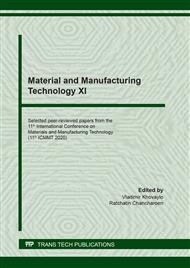p.21
p.27
p.34
p.40
p.49
p.55
p.61
p.67
p.73
High-Cycle-Fatigue Characterization of an Additive Manufacturing 17-4 PH Stainless Steel
Abstract:
On the one hand, many mechanical components manufactured through additive technologies are optimized in terms of stiffness/weight or strength/weight thanks to lattice structures. On the other hand, the high complexity of these components often impedes further finishing operations and, therefore, the fatigue strength can be compromised. The high surface to volume ratio together with the high roughness, typical of additive manufactured components, promote the crack nucleation. In this paper, the High-Cycle-Fatigue (HCF) behavior of the 17-4 PH stainless steel (SS) was characterized. Cylindrical samples, manufactured via Selective Laser Melting (SLM) with an EOS M280, were tested in the as-build condition through a STEPLab UD04 fatigue-testing machine. In particular, a preliminary quasi-static traction test was performed on a sample to obtain the yield strength (σY = 570 MPa) and the ultimate tensile strength (UTS = 1027 MPa). Fatigue tests were performed on samples at different stress levels in order to characterize the whole Stress-Number of cycles (S-N) curve (Wöhler diagram). More specifically, the stair-case method combined with the Dixon approach were exploited to calculate the fatigue limit (σF = 271 MPa). The obtained results were compared with those present in literature for the same material and they are coherent with previous researches
Info:
Periodical:
Pages:
49-54
Citation:
Online since:
February 2021
Authors:
Keywords:
Price:
Сopyright:
© 2021 Trans Tech Publications Ltd. All Rights Reserved
Share:
Citation:


